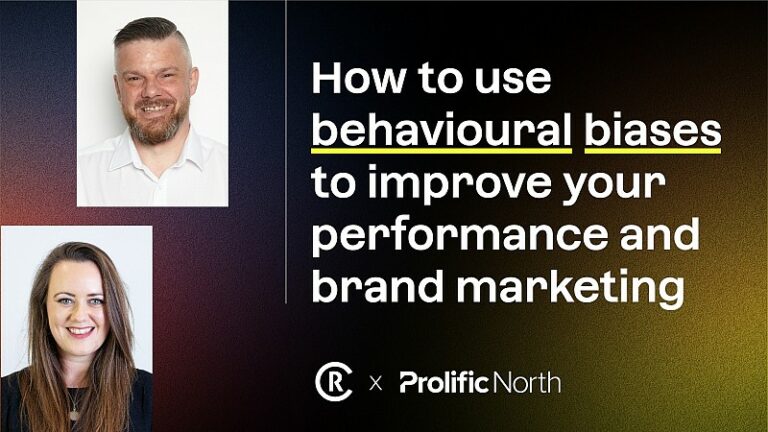Power of behavioural nudges and biases – why marketers should take note
The duo kicked off the session by sharing an introduction to nudges and biases, what they are and how they can be applied to marketing strategies.
“We know that Google has built these layered algorithms that are designed to try and mimic human behaviour, so as marketers we need to embrace that,” said Malcolm Slade.
On what biases and nudges are, Aspinall explained biases are irrational beliefs or behaviours that can unconsciously impact the decision-making process.
“From a marketing perspective, we need to understand those because that gives you the foundation for why people are acting in different ways,” she said.
Providing an insightful overview of how biases develop from infancy through to adulthood, Slade pointed out how initial influences develop through family and then as adults can extend into various influences from specific events, stimuluses and situations in society.
“The easiest one to think about is what we call the exposure effect. This is the concept of the more you see something, the more you’re influenced by it,” he explained.
Whereas nudges are ways to influence behaviour by tapping into those biases. “A nudge is a way of altering someone’s behaviour without offering economic incentives,” she said.
Nudges have even sat at the heart of government operations too. In 2010, David Cameron’s government set up its own ‘Nudge Unit’, utilising behavioural science towards driving policies. But it’s not just for governments, it can be a “really powerful” tool that the marketing world can tap into, said Aspinall, if both biases and nudges are blended together to drive behaviour.
Showcasing how brands are able to bring nudges to life, she pointed to how Bose drives behaviour effectively with just a few simple words ‘only a few hours left to save big’ which is a “classic nudge” to prompt a consumer into making a swift purchase.
With brands such as PrettyLittleThing and Booking.com, there are examples where nudges may be built in such as showing a consumer how many other users are looking at the same item at the same time.
“It instils that level of urgency and competitiveness within the particular thing you were looking at,” explained Slade.
CreativeRace’s top 10 nudges for marketers and real-life examples
Although there are “hundreds of nudges” a marketer can absorb into their arsenal, Aspinall and Slade set out the top 10 nudges CreativeRace works with most.
Loss Aversion
Deriving from the bias that loss is painful and that consumers don’t like missing out, this nudge has been used “lots of times in marketing and advertising very effectively”.
Using an example with a successful Specsavers advert, instead of focusing on getting your eyes tested it shows what you might lose if you don’t – your sight.
“If you look out for ads that are trying to encourage you to do something, you’ll see this coming through time and time again, really highlighting what you might lose if you don’t do it rather than what you might gain.”
Slade detailed a similar example with hearing healthcare company Amplifon, where a large-scale campaign was built around Google Street view through an explorative 3D experience with real-world sounds.
Endowment bias
This nudge is based around how consumers may value a product more if they own it, such as a seller overestimating the value of their property in comparison with an estate agent with no emotional ties.
“What’s really important here for marketers is the importance of putting yourself or your customer into it. So the personalisation, the idea of weaving a customer into that product as early as we possibly can, is absolutely critical.”
Framing
Consumers are “hugely influenced” by the way a choice is framed and presented and it can have a major impact on how they act.
For example, a frozen yoghurt that contains 20% fat versus one that is 80% fat free – most will opt for the 80% fat free option.
“You can see the power of words and the power of framing is really important in how people act and how they think,” said Aspinall.
Relativity
A choice can be driven when items are positioned among others for comparison. Even when a product might typically be considered a pricey option, a customer may opt for the expensive option if they feel they are getting more value.
“By putting a higher priced option in the mix, the idea of relativity and the nudge of relativity will encourage people to trade up away from the cheapest option. This taps into the bias around not wanting to lower, making sure you’re picking the safest option.”
Slade explained this can be demonstrated even in website layouts, where the order products are in are carefully selected as users tend to “gravitate” towards the middle option.
A tip from Aspinall if you ever want to save money on dinner – “you should always choose the cheapest bottle of wine on the menu because they put the higher margin ones in the middle”.
Tyranny of Choice
This is based on the idea that “less is more”.
“Ease is one of the most important things that marketers can do for customers and their clients. Make it easy for people to know what you’re doing, what to buy from you and how to buy from you,” she said.
With a mass of choices now available on the market, customers often face a “choice paralysis” when shopping around so marketers need to be able to guide them to make that decision.
If a website layout is filled with menus and complex navigation pathways, potential customers won’t make a decision because they’ll end up “overwhelmed,” explained Slade.
Social Proof
Social proof is driven by the bias that individuals like to conform to group behaviour.
“We might not want to admit it, but we do. The NHS captured this beautifully with their vaccination campaign,” explained Aspinall.
Rather than urging a target audience to get their vaccinations, the NHS nudged behaviour with the strapline ‘join the millions already vaccinated’, which creates the idea of missing out.
For Slade, he explained this nudge can have its negatives too. “You have to be careful where you’re applying it because there can be situations where being part of a collective isn’t necessarily the right thing for your customer”.
Using an example of high end fashion, customers may want limited items rather than readily available pieces anyone can access.
Availability Bias
This taps into the bias that if you see something “it’s very much front of mind”.
Aspinall said: “This is just quite an important nudge because it’s remembering that your consumers are more likely to be worried about the things that are front of mind, being aware of what they are, and how it impacts them is really important.”
Priming Bias
What a consumer may see or hear before making a choice can “directly impact how they behave”.
“The environment and the wider area needs to replicate what you’re trying to sell. If it’s luxury and high end, everything has to feel like that. But also online, we look at website navigation, does the whole flow of the customer journey and experience match what you’re trying to sell?”
Slade echoed this, pointing out how everything from page layouts to the user journey must reinforce what the marketing goal is trying to achieve.
Anchoring
Demonstrated with online retailers such as PrettyLittleThing, customers rely on the first piece of information offered before making a decision such as how many people are looking at an item and if an item has been reduced from a significant cost.
On a website, Slade explained examples of anchoring can be seen by driving customers to what retailers are trying to “push to try and sell” such as recommended products.
Salience
The final nudge, Salience, is based on the idea that the more consumers are exposed to a product it increases consideration.
“This nudge has been used time and time again,” said Aspinall. “It’s a really powerful tool for marketers.”
It can drive behaviour such as in supermarkets where sugary or salty snacks have been removed from the checkout tills to placing the fruit and vegetable aisle right by the front door so customers can’t miss it. “Embedding is such a key tool we have in our arsenal,” she added.
Although the duo detailed how these top 10 nudges can be used effectively with biases to become powerful marketing tools, Aspinall emphasised that although there are “many, many more”, they shouldn’t be used all at once.
“These are to be cherry-picked and you’d never use them all together in any one situation. It’s about picking the right moment to use them.”










